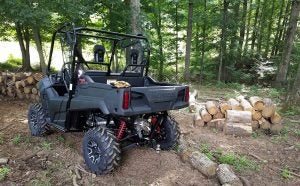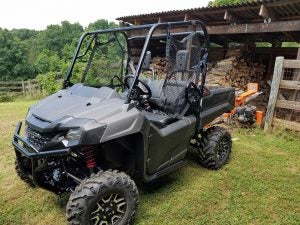There’s nothing about my land that’s neat, tidy, or flat. From the deadfall in our side pasture to the large elevation change going toward our back pond to the well worn livestock areas that are caked with ankle-biting divots, we simply don’t do fancy. So when Honda’s Pioneer 700 side-by-side arrived, I was geared up to see how much utility I could get out of this utility vehicle.
And it all started in the woods.
My favorite chore to give to a utility vehicle is transporting sawed firewood to the shed so that it can begin the seasoning process. This gives me the opportunity to test the suspension, the off-road handling, the balance, and frame durability. Before even putting the key in the ignition, two things on the Pioneer 700 jumped out at me:
1) The stock Blackstone HP-007 25×10.00-12 OTR tires were wonderfully more aggressive than other vehicles I’ve driven. I know that rugged tires can damage manicured lawns and be uncomfortable on pavement, but those places were hardly my prime destinations for this machine. Instead, I was traversing holes and climbing over small limbs — not to mention getting myself in a few tight spots along hilly fencelines where a good grip of the earth was essential.
2) At 10.7 inches, the machine’s standard ground clearance was perfect for all the same reasons I mentioned under the first point. At no time was I worried about the machine scraping the ground beneath me, even when having it work its way over the lip of some pretty steep inclines. The Pioneer gave me great mobility everywhere I wanted to go.

I’m generally someone who values versatility, since I rarely overwork a machine in one specific area. That means:
- I got good use out of the 1,000-pound capacity bed, but probably only reached three-fourths of that weight hauling wood, concrete blocks, tools, and other materials. And the tilt bed, which includes a hydraulic assist strut, made emptying it all that much easier;
- I took the 700 out onto the pavement, but only got it up to around 30 mph, while the listed top speed is 45 (my curvy roads aren’t conducive to that);
- I effortlessly hauled a 650-pound log splitter with the 2-inch hitch, which is less than half of what the machine is capable of. Unfortunately, my horse trailer is way too heavy to pull with the Pioneer, so the log splitter was the heaviest I could test while being safe.
These are my everyday-type of tasks, and the Pioneer 700 handled them perfectly. Because the Pioneer 700 sits right in the middle of Honda’s Pioneer Multipurpose Side By Side lineup (Pioneer 500 and 1000 being the other two models), it’s versatility was apparent. It did a great job of balancing big jobs and capability on rugged adventures.

Toss in the opportunity to shift from automatic transmission to manual on the fly via the steering column mounted paddle shifters, there was certainly a lot for me to love, especially as someone who wants to do so many different kinds of things with one vehicle (even if I do lean more toward the practical side of things over recreation).
If you’re a raw specs kind of person, here are the highlights of what you’ve got from the Pioneer 700:
- Engine Type: 675cc liquid-cooled OHV single-cylinder four-stroke
- Induction: Fuel Injection (PGM-FI), 40mm throttle body
- Ignition: Full-transistorized type with electronic advance
- Transmission: Automotive-style automatic transmission with hydraulic torque converter, three forward gears and Reverse. Three drive modes include 2WD, 4WD and 4WD with Differential lock. AT/MT modes with paddle shifting on the deluxe models.
- Driveline: Direct front and rear driveshafts
- Front Suspension: Independent double-wishbone; 7.9 inches travel
- Rear Suspension: Independent double-wishbone; 9.1 inches travel
- Length/Width/Height: 114.7 inches, 59.7 inches, 77.6 inches
- Wheelbase: 76.8 inches
- Bed Capacity: 1,000 pounds
- Towing Capacity: 1,500 pounds
- Ground Clearance: 10.7 inches
- Turning Radius: 14.8 feet
- Curb Weight: 1,268 pounds — Includes all standard equipment, required fluids and full tank of fuel.
- Fuel Capacity: 7.9 gallons, including 1.2-gallon reserve
Lastly, no utility vehicle is worth its weight in salt if it’s not built to incorporate some fun accessories: The long list for those with the Honda Pioneer 700 include a bed extend, cab-frame cargo bag, under-dash storage pocket, fabric doors, auxiliary lights, brush guard, floor mats, storage covers … and, of course, additional cup holders.



